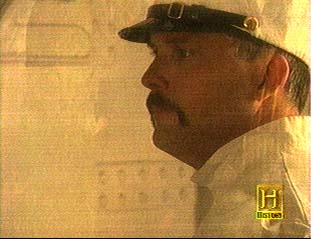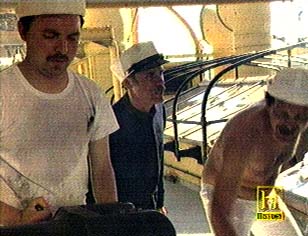

The Living History Crew of the OLYMPIA was involved in the filming of "Spanish American War: Birth of a Superpower" where scenes requiring naval crewmen were involved. Below is some information on that experience. The production aired on the History Channel as part of its "As it Happened" series.
General:
The Living History Crew of the OLYMPIA was contacted by Lou Reda Productions of Easton, Pennsylvania because of the re-enactment group's involvment with the naval history of the period, and because of the unique combination of its being an historical crew which works aboard the only surviving naval vessel of the Spanish American War Period, the USFS OLYMPIA.
 The
crew met with producer Sammy Jackson and director Tom Musto to discuss
the project. All told, filming of the crew occurred over a two day
period aboard the vessel (though the film crew did much additional filming
without the historian crew being present). Later, additional filming was
done at a park in Easton, PA and at an indoor pool at Lafayette College,
near Easton. Both Sammy Jackson and Tom Musto proved to be men of
limitless patience, constant good humor and professionalism. All of the
filmcrew's personnel were found to be very helpful, innovative, and friendly
throughout the project.
The
crew met with producer Sammy Jackson and director Tom Musto to discuss
the project. All told, filming of the crew occurred over a two day
period aboard the vessel (though the film crew did much additional filming
without the historian crew being present). Later, additional filming was
done at a park in Easton, PA and at an indoor pool at Lafayette College,
near Easton. Both Sammy Jackson and Tom Musto proved to be men of
limitless patience, constant good humor and professionalism. All of the
filmcrew's personnel were found to be very helpful, innovative, and friendly
throughout the project.
The "Living History Crew of the OLYMPIA" found that its members were not only to represent the crew of that venerable ship, but would be seen whenever naval scenes would be needed. Hence, the crew became crewmen of the MAINE, the BROOKLYN and any other naval vessel where they were needed.
Filming on board the OLYMPIA began on a Friday evening in what would turned out to be a very busy weekend for the crew. After the filming work was completed with Lou Reda Productions, a Spanish filmcrew from Televsion Espana of Madrid would come aboard to film for a day.
The work began with scenes being filmed within the cramped quarters of the vessel's pilot house. A variety of scenes were filmed with two seprate crews simulating peacetime and battle situations. Efforts were made to recreate the actual sensations that the bridge crew would feel during battle, such as the concussion and flash of the guns. During these scenes, the re-enactors were introduced to the smoke machines, which would come to be a major part of their memory of the event! Later, scenes were filmed with a crew firing the functional port aft six pounder.
 Saturday
began with hectic scenes of the loading and firing of the OLYMPIA's workhorse
battery - the five inch gun. Each portion of the loading process was filmed
individually, and then overall scenes were filmed. The gun deck was (seemingly)
again thick with acrid smoke, with grimy and sweaty men working to
feed the guns with a steady supply of ammunition. Even the ejecting of
a spent casing was simulated, which involved some tricky camera work, since
the shell casings presently available do not eject.
Saturday
began with hectic scenes of the loading and firing of the OLYMPIA's workhorse
battery - the five inch gun. Each portion of the loading process was filmed
individually, and then overall scenes were filmed. The gun deck was (seemingly)
again thick with acrid smoke, with grimy and sweaty men working to
feed the guns with a steady supply of ammunition. Even the ejecting of
a spent casing was simulated, which involved some tricky camera work, since
the shell casings presently available do not eject.
After several hours of work on the five inch guns, the work turned more leisurely, with the historian crewmen filmed relaxing in hammocks, reading, playing games such as mah jong, etc. The scene was filmed in the area adjacent to the OLYMPIA's galley, which served as the mess area and berth area for a portion of the original crew. Hammocks were slung to the original hooks, and the scene came off with a high degree of accuracy. Next, an officer's meeting was held, with four officers surrounding a table in discussion. Later, a lone officer was filmed quietly working.
 The
production then moved topside, with the signal crew at work with the signal
halyards, raising and lowering signals using the International Code of
Signals, and also using the Myer "wigwag" system. The action then
moved back to the six inch gun for additional work.
The
production then moved topside, with the signal crew at work with the signal
halyards, raising and lowering signals using the International Code of
Signals, and also using the Myer "wigwag" system. The action then
moved back to the six inch gun for additional work.
The afternoon was spent in a variety of scenes. The crew's bugler was filmed sounding various calls. Later, the entire band was filmed playing aboard the forward turret, reminiscent of the OREGON's band at the Battle of Santiago. In addition to scenes of things such as running feet, a homecoming scene was filmed with one of the crewmen returning to port to be met by his family. The last scene filmed aboard the ship was of the crew's harmonica player seated on the barrel of a five inch gun, playing a tune to while away the time.
Over a month later, in some creative filming, Producer Sammy Jackson and Director Tom Musto again met wth some of the OLYMPIA crewmen, and the captain of Independent Battery I, Pennsylvania Light Artillery. Seveal of the OLYMPIA's crewmen are also members of this Civil War living history organization, and the group's three inch ordnance rifle was to be used to simulate the muzzleblasts of the large six, eight, twelve and thirteen inch guns of the American fleet. When filmed with no size reference, the three inch muzzle could pose as any of these guns. For added realism, water was used in some of the background...which in reality was the waters of the Lehigh River, not Manila Bay or the Caribbean. The filmcrew pulled off the effect masterfully, even concocting backdrops which appeared as part of a ship.
The last scene filmed occurred several weeks later at Lafayette College. In the darkened indoor pool, crewmen donned their white uniforms to float in the darkness, surrounded by the ever-present smoke, to simulate the terrible scenes immediately after the loss of the MAINE.
The crew's last involvement included a review of the script for any small inaccuracies.
The filming project was a great success and an excellent memory for all of the crewmen involved, which included:
Kirk Bonnevier
Mary Pat Bonnevier
Mike Borsuk
Jared Brooks
Ken Brooks
Tom Johnstone
Casey Magargle
William Magargle
Jack L. McSherry, Jr.
Patrick McSherry
Brian Miller
Gregg Reinsmith
Steve Williams
Steven Williams

